A300CAW Resit: Dissertation on Power Posing and Student Anxiety
VerifiedAdded on 2023/06/10
|9
|2674
|413
Essay
AI Summary
This essay provides a critical review of a dissertation exploring the effects of high and low power posing on student anxiety levels in a mock interview setting. The review covers various aspects of the dissertation, including the appropriateness of the research question, the structure and organization of the research, the methods of data collection and interpretation, the use of sources and citation styles, and the use of academic language. It identifies both strengths and weaknesses in the dissertation, such as the well-defined research topic and the flawed data collection due to a small sample size and outdated sources. The essay also discusses the opportunities and challenges encountered during the research process and reflects on the feedback received from the tutor. The analysis concludes by highlighting the importance of addressing the identified flaws to strengthen the research and dissemination of findings.
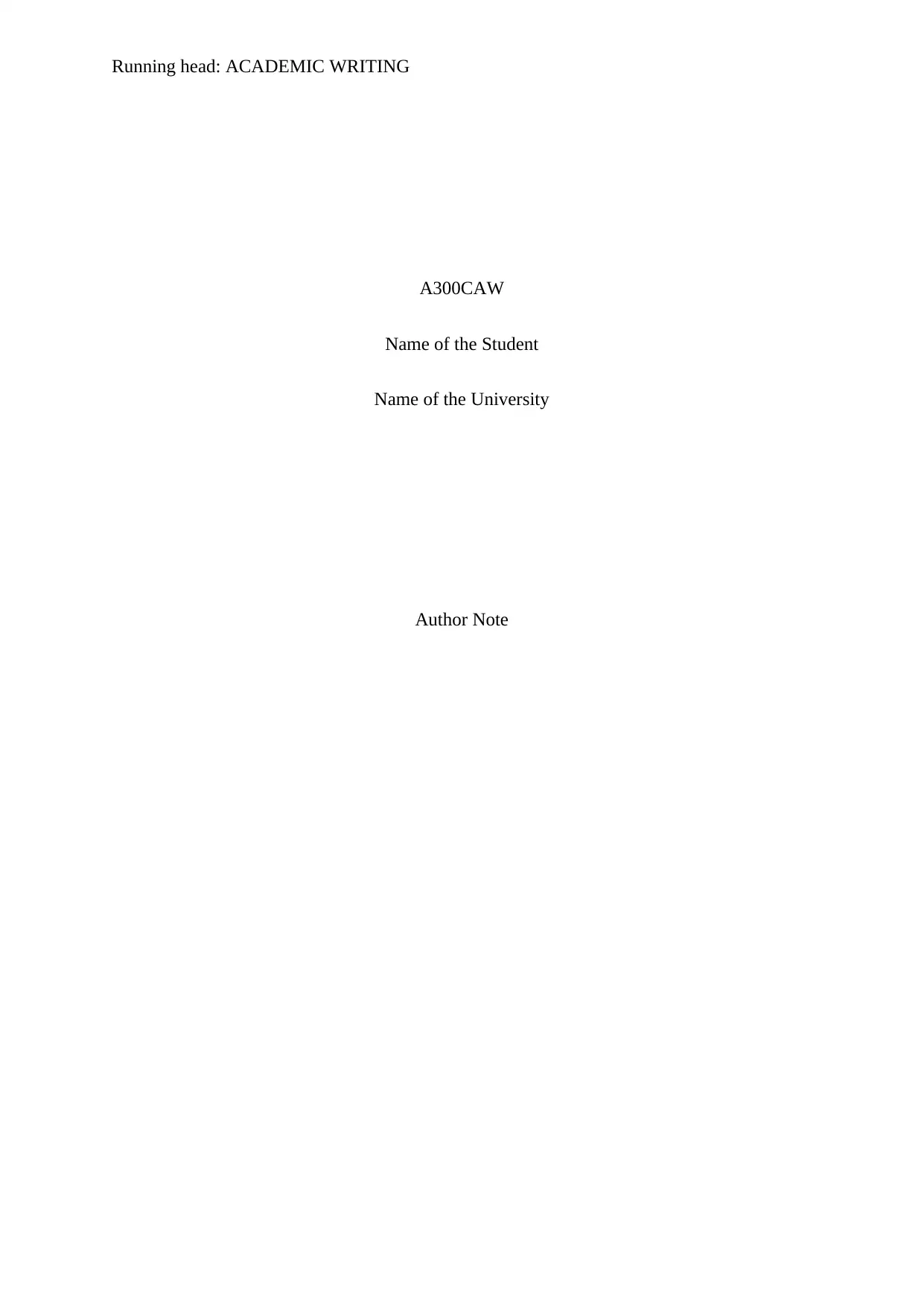
Running head: ACADEMIC WRITING
A300CAW
Name of the Student
Name of the University
Author Note
A300CAW
Name of the Student
Name of the University
Author Note
Paraphrase This Document
Need a fresh take? Get an instant paraphrase of this document with our AI Paraphraser
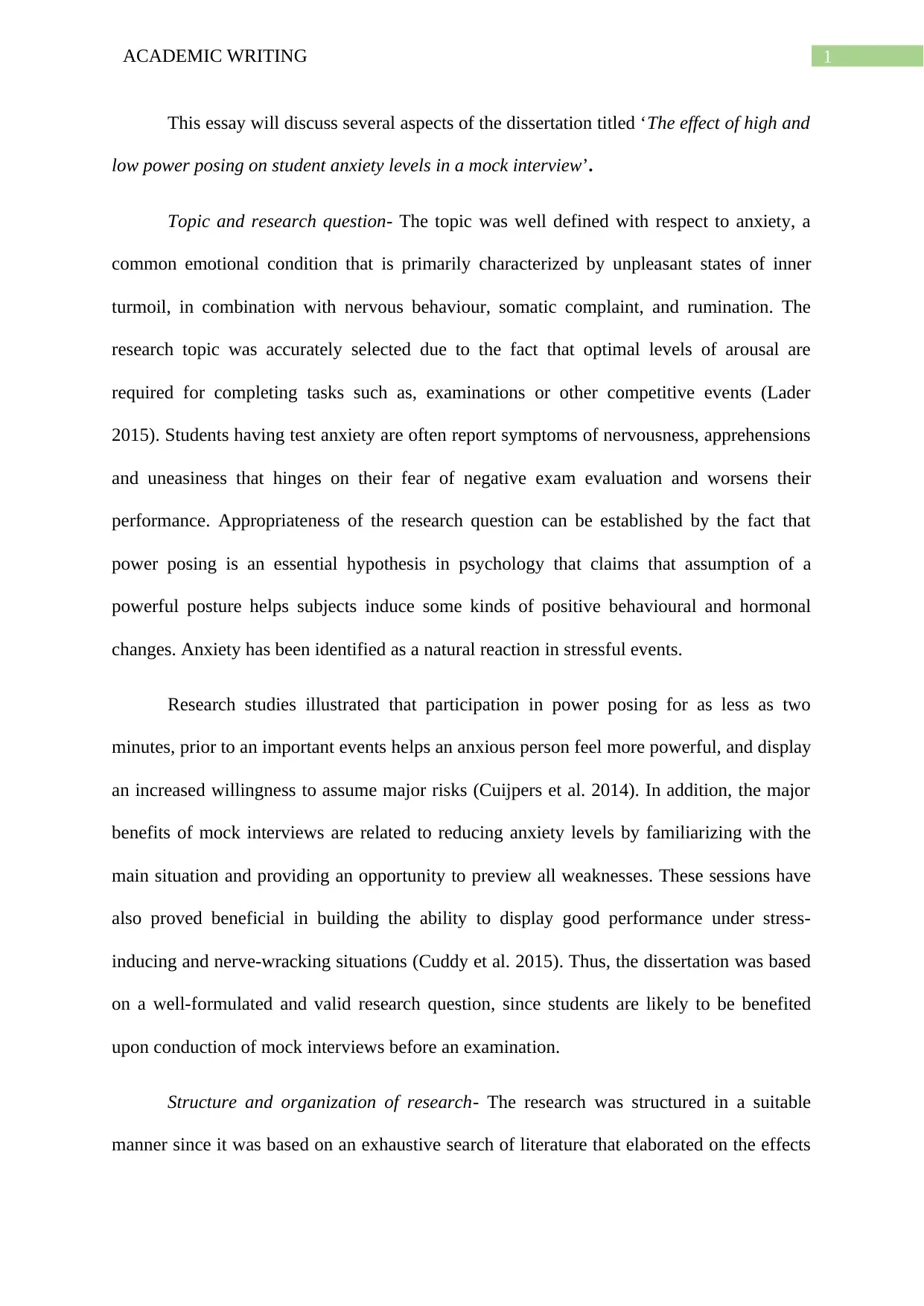
1ACADEMIC WRITING
This essay will discuss several aspects of the dissertation titled ‘The effect of high and
low power posing on student anxiety levels in a mock interview’.
Topic and research question- The topic was well defined with respect to anxiety, a
common emotional condition that is primarily characterized by unpleasant states of inner
turmoil, in combination with nervous behaviour, somatic complaint, and rumination. The
research topic was accurately selected due to the fact that optimal levels of arousal are
required for completing tasks such as, examinations or other competitive events (Lader
2015). Students having test anxiety are often report symptoms of nervousness, apprehensions
and uneasiness that hinges on their fear of negative exam evaluation and worsens their
performance. Appropriateness of the research question can be established by the fact that
power posing is an essential hypothesis in psychology that claims that assumption of a
powerful posture helps subjects induce some kinds of positive behavioural and hormonal
changes. Anxiety has been identified as a natural reaction in stressful events.
Research studies illustrated that participation in power posing for as less as two
minutes, prior to an important events helps an anxious person feel more powerful, and display
an increased willingness to assume major risks (Cuijpers et al. 2014). In addition, the major
benefits of mock interviews are related to reducing anxiety levels by familiarizing with the
main situation and providing an opportunity to preview all weaknesses. These sessions have
also proved beneficial in building the ability to display good performance under stress-
inducing and nerve-wracking situations (Cuddy et al. 2015). Thus, the dissertation was based
on a well-formulated and valid research question, since students are likely to be benefited
upon conduction of mock interviews before an examination.
Structure and organization of research- The research was structured in a suitable
manner since it was based on an exhaustive search of literature that elaborated on the effects
This essay will discuss several aspects of the dissertation titled ‘The effect of high and
low power posing on student anxiety levels in a mock interview’.
Topic and research question- The topic was well defined with respect to anxiety, a
common emotional condition that is primarily characterized by unpleasant states of inner
turmoil, in combination with nervous behaviour, somatic complaint, and rumination. The
research topic was accurately selected due to the fact that optimal levels of arousal are
required for completing tasks such as, examinations or other competitive events (Lader
2015). Students having test anxiety are often report symptoms of nervousness, apprehensions
and uneasiness that hinges on their fear of negative exam evaluation and worsens their
performance. Appropriateness of the research question can be established by the fact that
power posing is an essential hypothesis in psychology that claims that assumption of a
powerful posture helps subjects induce some kinds of positive behavioural and hormonal
changes. Anxiety has been identified as a natural reaction in stressful events.
Research studies illustrated that participation in power posing for as less as two
minutes, prior to an important events helps an anxious person feel more powerful, and display
an increased willingness to assume major risks (Cuijpers et al. 2014). In addition, the major
benefits of mock interviews are related to reducing anxiety levels by familiarizing with the
main situation and providing an opportunity to preview all weaknesses. These sessions have
also proved beneficial in building the ability to display good performance under stress-
inducing and nerve-wracking situations (Cuddy et al. 2015). Thus, the dissertation was based
on a well-formulated and valid research question, since students are likely to be benefited
upon conduction of mock interviews before an examination.
Structure and organization of research- The research was structured in a suitable
manner since it was based on an exhaustive search of literature that elaborated on the effects
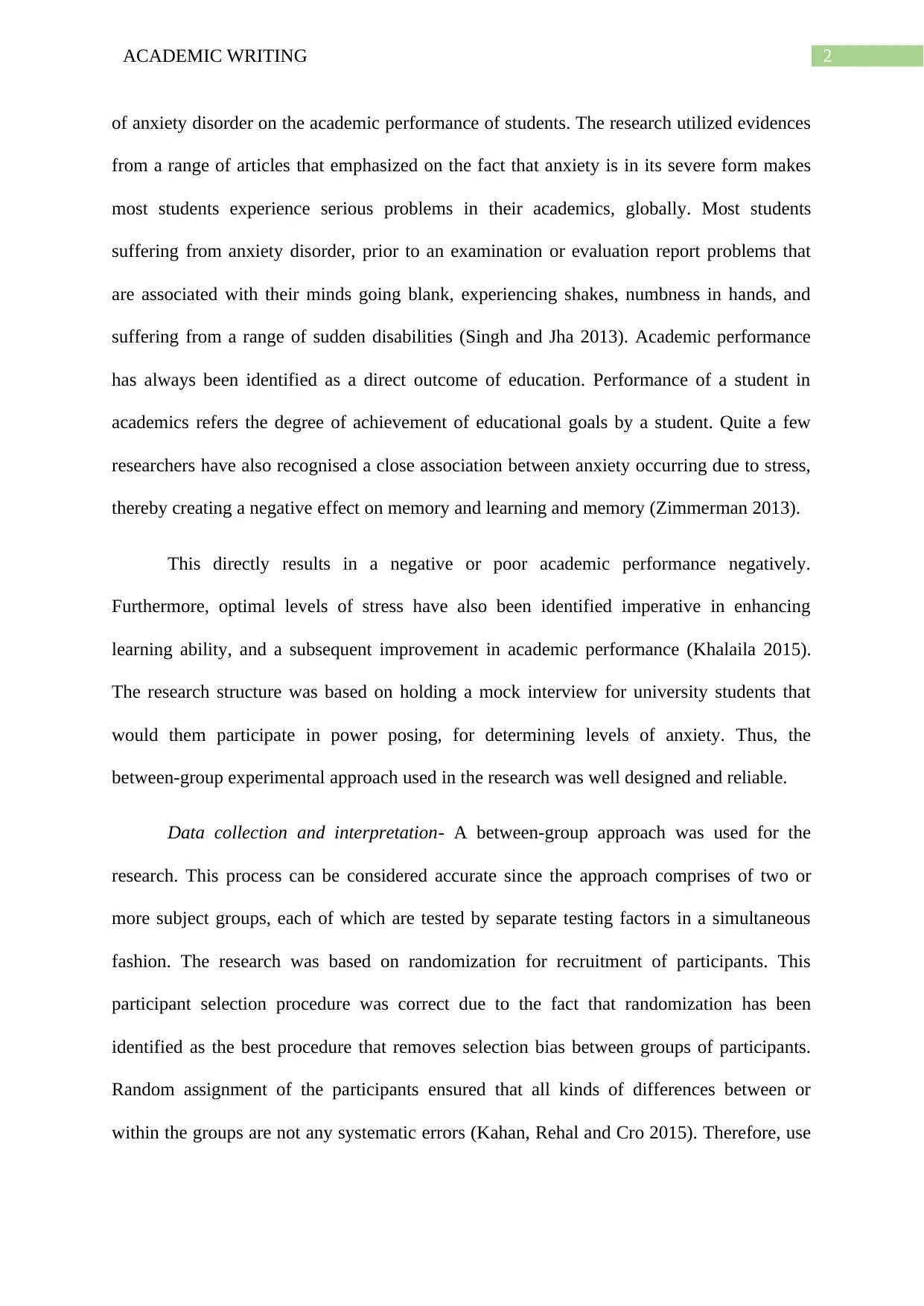
2ACADEMIC WRITING
of anxiety disorder on the academic performance of students. The research utilized evidences
from a range of articles that emphasized on the fact that anxiety is in its severe form makes
most students experience serious problems in their academics, globally. Most students
suffering from anxiety disorder, prior to an examination or evaluation report problems that
are associated with their minds going blank, experiencing shakes, numbness in hands, and
suffering from a range of sudden disabilities (Singh and Jha 2013). Academic performance
has always been identified as a direct outcome of education. Performance of a student in
academics refers the degree of achievement of educational goals by a student. Quite a few
researchers have also recognised a close association between anxiety occurring due to stress,
thereby creating a negative effect on memory and learning and memory (Zimmerman 2013).
This directly results in a negative or poor academic performance negatively.
Furthermore, optimal levels of stress have also been identified imperative in enhancing
learning ability, and a subsequent improvement in academic performance (Khalaila 2015).
The research structure was based on holding a mock interview for university students that
would them participate in power posing, for determining levels of anxiety. Thus, the
between-group experimental approach used in the research was well designed and reliable.
Data collection and interpretation- A between-group approach was used for the
research. This process can be considered accurate since the approach comprises of two or
more subject groups, each of which are tested by separate testing factors in a simultaneous
fashion. The research was based on randomization for recruitment of participants. This
participant selection procedure was correct due to the fact that randomization has been
identified as the best procedure that removes selection bias between groups of participants.
Random assignment of the participants ensured that all kinds of differences between or
within the groups are not any systematic errors (Kahan, Rehal and Cro 2015). Therefore, use
of anxiety disorder on the academic performance of students. The research utilized evidences
from a range of articles that emphasized on the fact that anxiety is in its severe form makes
most students experience serious problems in their academics, globally. Most students
suffering from anxiety disorder, prior to an examination or evaluation report problems that
are associated with their minds going blank, experiencing shakes, numbness in hands, and
suffering from a range of sudden disabilities (Singh and Jha 2013). Academic performance
has always been identified as a direct outcome of education. Performance of a student in
academics refers the degree of achievement of educational goals by a student. Quite a few
researchers have also recognised a close association between anxiety occurring due to stress,
thereby creating a negative effect on memory and learning and memory (Zimmerman 2013).
This directly results in a negative or poor academic performance negatively.
Furthermore, optimal levels of stress have also been identified imperative in enhancing
learning ability, and a subsequent improvement in academic performance (Khalaila 2015).
The research structure was based on holding a mock interview for university students that
would them participate in power posing, for determining levels of anxiety. Thus, the
between-group experimental approach used in the research was well designed and reliable.
Data collection and interpretation- A between-group approach was used for the
research. This process can be considered accurate since the approach comprises of two or
more subject groups, each of which are tested by separate testing factors in a simultaneous
fashion. The research was based on randomization for recruitment of participants. This
participant selection procedure was correct due to the fact that randomization has been
identified as the best procedure that removes selection bias between groups of participants.
Random assignment of the participants ensured that all kinds of differences between or
within the groups are not any systematic errors (Kahan, Rehal and Cro 2015). Therefore, use
⊘ This is a preview!⊘
Do you want full access?
Subscribe today to unlock all pages.

Trusted by 1+ million students worldwide
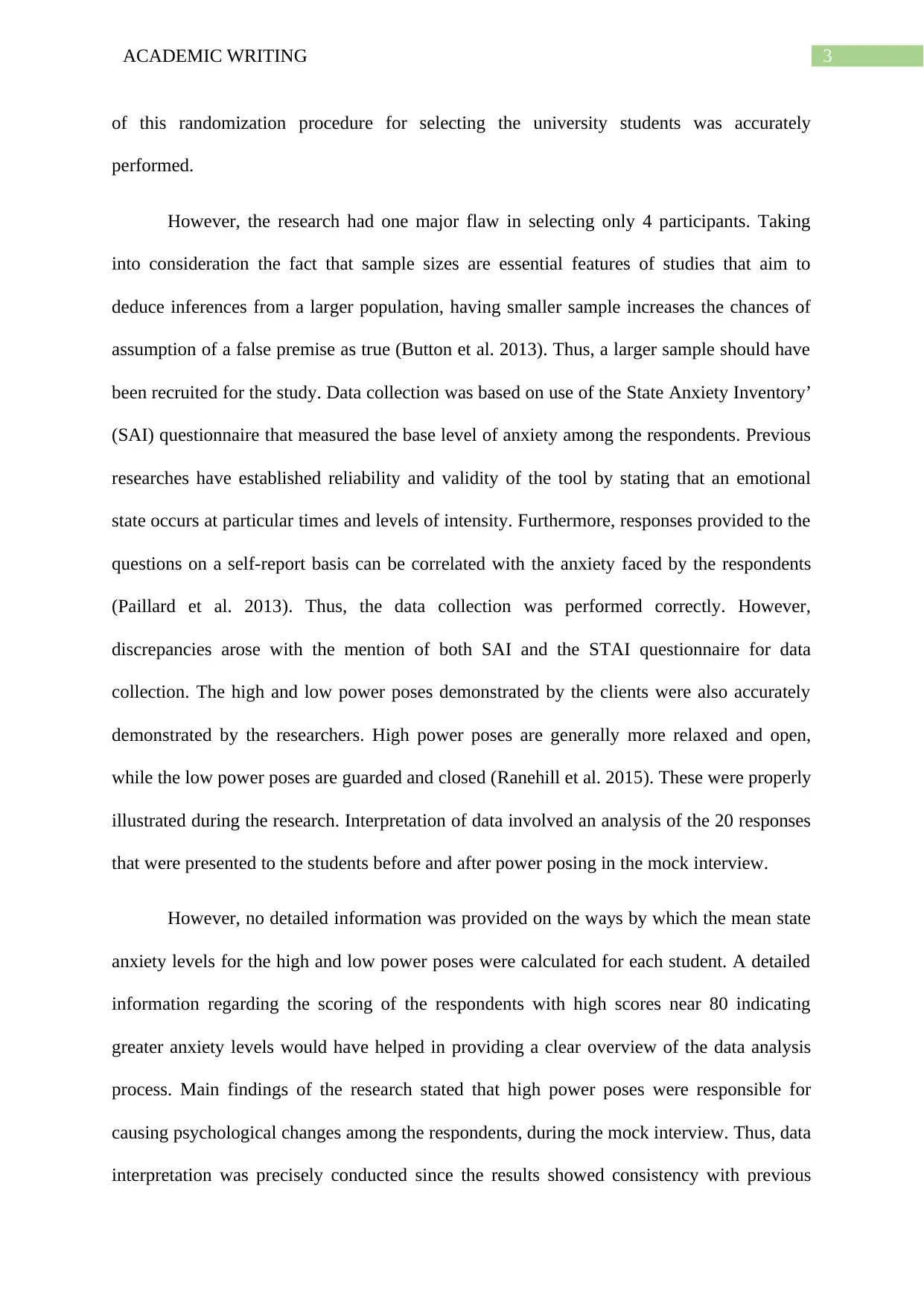
3ACADEMIC WRITING
of this randomization procedure for selecting the university students was accurately
performed.
However, the research had one major flaw in selecting only 4 participants. Taking
into consideration the fact that sample sizes are essential features of studies that aim to
deduce inferences from a larger population, having smaller sample increases the chances of
assumption of a false premise as true (Button et al. 2013). Thus, a larger sample should have
been recruited for the study. Data collection was based on use of the State Anxiety Inventory’
(SAI) questionnaire that measured the base level of anxiety among the respondents. Previous
researches have established reliability and validity of the tool by stating that an emotional
state occurs at particular times and levels of intensity. Furthermore, responses provided to the
questions on a self-report basis can be correlated with the anxiety faced by the respondents
(Paillard et al. 2013). Thus, the data collection was performed correctly. However,
discrepancies arose with the mention of both SAI and the STAI questionnaire for data
collection. The high and low power poses demonstrated by the clients were also accurately
demonstrated by the researchers. High power poses are generally more relaxed and open,
while the low power poses are guarded and closed (Ranehill et al. 2015). These were properly
illustrated during the research. Interpretation of data involved an analysis of the 20 responses
that were presented to the students before and after power posing in the mock interview.
However, no detailed information was provided on the ways by which the mean state
anxiety levels for the high and low power poses were calculated for each student. A detailed
information regarding the scoring of the respondents with high scores near 80 indicating
greater anxiety levels would have helped in providing a clear overview of the data analysis
process. Main findings of the research stated that high power poses were responsible for
causing psychological changes among the respondents, during the mock interview. Thus, data
interpretation was precisely conducted since the results showed consistency with previous
of this randomization procedure for selecting the university students was accurately
performed.
However, the research had one major flaw in selecting only 4 participants. Taking
into consideration the fact that sample sizes are essential features of studies that aim to
deduce inferences from a larger population, having smaller sample increases the chances of
assumption of a false premise as true (Button et al. 2013). Thus, a larger sample should have
been recruited for the study. Data collection was based on use of the State Anxiety Inventory’
(SAI) questionnaire that measured the base level of anxiety among the respondents. Previous
researches have established reliability and validity of the tool by stating that an emotional
state occurs at particular times and levels of intensity. Furthermore, responses provided to the
questions on a self-report basis can be correlated with the anxiety faced by the respondents
(Paillard et al. 2013). Thus, the data collection was performed correctly. However,
discrepancies arose with the mention of both SAI and the STAI questionnaire for data
collection. The high and low power poses demonstrated by the clients were also accurately
demonstrated by the researchers. High power poses are generally more relaxed and open,
while the low power poses are guarded and closed (Ranehill et al. 2015). These were properly
illustrated during the research. Interpretation of data involved an analysis of the 20 responses
that were presented to the students before and after power posing in the mock interview.
However, no detailed information was provided on the ways by which the mean state
anxiety levels for the high and low power poses were calculated for each student. A detailed
information regarding the scoring of the respondents with high scores near 80 indicating
greater anxiety levels would have helped in providing a clear overview of the data analysis
process. Main findings of the research stated that high power poses were responsible for
causing psychological changes among the respondents, during the mock interview. Thus, data
interpretation was precisely conducted since the results showed consistency with previous
Paraphrase This Document
Need a fresh take? Get an instant paraphrase of this document with our AI Paraphraser
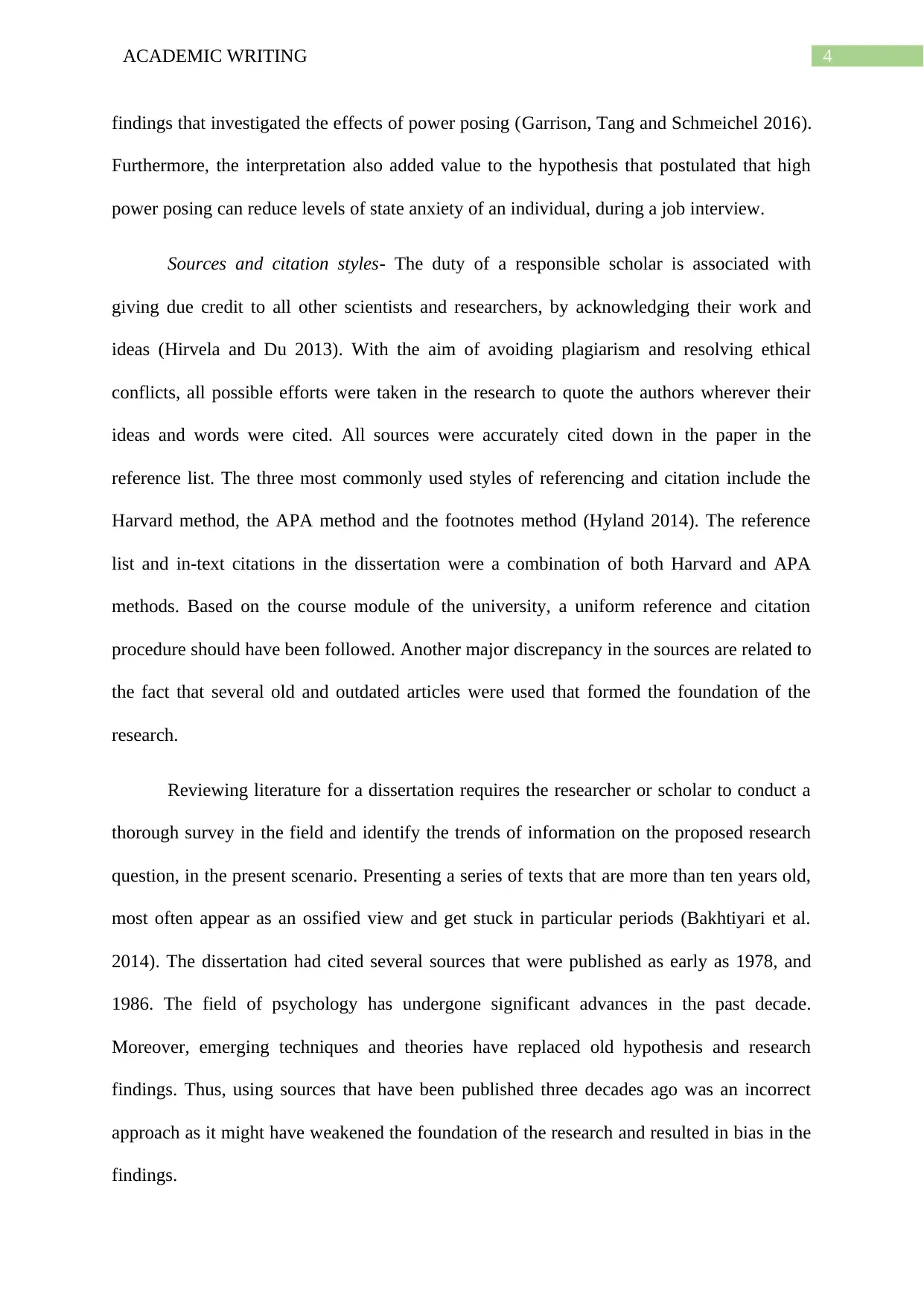
4ACADEMIC WRITING
findings that investigated the effects of power posing (Garrison, Tang and Schmeichel 2016).
Furthermore, the interpretation also added value to the hypothesis that postulated that high
power posing can reduce levels of state anxiety of an individual, during a job interview.
Sources and citation styles- The duty of a responsible scholar is associated with
giving due credit to all other scientists and researchers, by acknowledging their work and
ideas (Hirvela and Du 2013). With the aim of avoiding plagiarism and resolving ethical
conflicts, all possible efforts were taken in the research to quote the authors wherever their
ideas and words were cited. All sources were accurately cited down in the paper in the
reference list. The three most commonly used styles of referencing and citation include the
Harvard method, the APA method and the footnotes method (Hyland 2014). The reference
list and in-text citations in the dissertation were a combination of both Harvard and APA
methods. Based on the course module of the university, a uniform reference and citation
procedure should have been followed. Another major discrepancy in the sources are related to
the fact that several old and outdated articles were used that formed the foundation of the
research.
Reviewing literature for a dissertation requires the researcher or scholar to conduct a
thorough survey in the field and identify the trends of information on the proposed research
question, in the present scenario. Presenting a series of texts that are more than ten years old,
most often appear as an ossified view and get stuck in particular periods (Bakhtiyari et al.
2014). The dissertation had cited several sources that were published as early as 1978, and
1986. The field of psychology has undergone significant advances in the past decade.
Moreover, emerging techniques and theories have replaced old hypothesis and research
findings. Thus, using sources that have been published three decades ago was an incorrect
approach as it might have weakened the foundation of the research and resulted in bias in the
findings.
findings that investigated the effects of power posing (Garrison, Tang and Schmeichel 2016).
Furthermore, the interpretation also added value to the hypothesis that postulated that high
power posing can reduce levels of state anxiety of an individual, during a job interview.
Sources and citation styles- The duty of a responsible scholar is associated with
giving due credit to all other scientists and researchers, by acknowledging their work and
ideas (Hirvela and Du 2013). With the aim of avoiding plagiarism and resolving ethical
conflicts, all possible efforts were taken in the research to quote the authors wherever their
ideas and words were cited. All sources were accurately cited down in the paper in the
reference list. The three most commonly used styles of referencing and citation include the
Harvard method, the APA method and the footnotes method (Hyland 2014). The reference
list and in-text citations in the dissertation were a combination of both Harvard and APA
methods. Based on the course module of the university, a uniform reference and citation
procedure should have been followed. Another major discrepancy in the sources are related to
the fact that several old and outdated articles were used that formed the foundation of the
research.
Reviewing literature for a dissertation requires the researcher or scholar to conduct a
thorough survey in the field and identify the trends of information on the proposed research
question, in the present scenario. Presenting a series of texts that are more than ten years old,
most often appear as an ossified view and get stuck in particular periods (Bakhtiyari et al.
2014). The dissertation had cited several sources that were published as early as 1978, and
1986. The field of psychology has undergone significant advances in the past decade.
Moreover, emerging techniques and theories have replaced old hypothesis and research
findings. Thus, using sources that have been published three decades ago was an incorrect
approach as it might have weakened the foundation of the research and resulted in bias in the
findings.
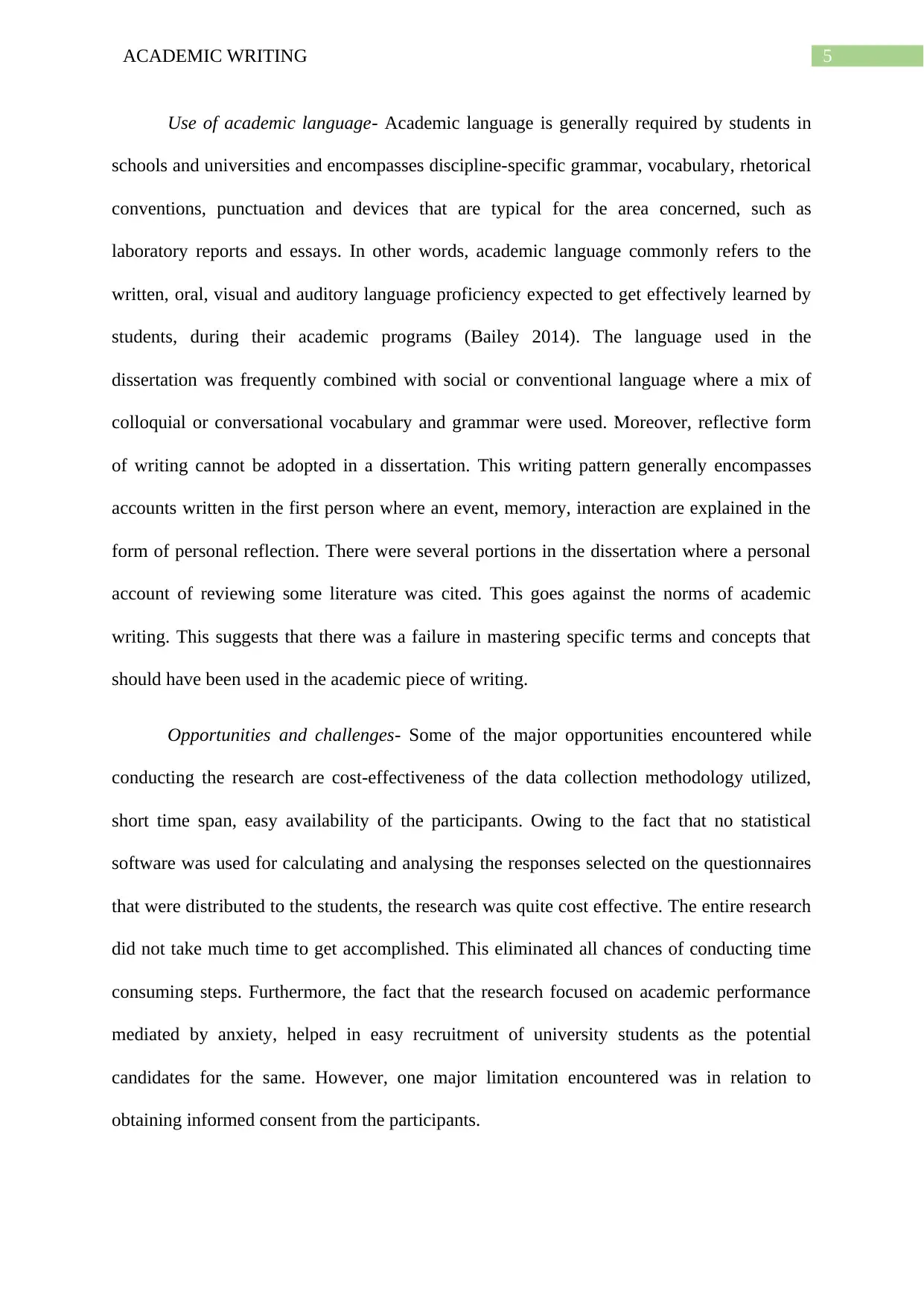
5ACADEMIC WRITING
Use of academic language- Academic language is generally required by students in
schools and universities and encompasses discipline-specific grammar, vocabulary, rhetorical
conventions, punctuation and devices that are typical for the area concerned, such as
laboratory reports and essays. In other words, academic language commonly refers to the
written, oral, visual and auditory language proficiency expected to get effectively learned by
students, during their academic programs (Bailey 2014). The language used in the
dissertation was frequently combined with social or conventional language where a mix of
colloquial or conversational vocabulary and grammar were used. Moreover, reflective form
of writing cannot be adopted in a dissertation. This writing pattern generally encompasses
accounts written in the first person where an event, memory, interaction are explained in the
form of personal reflection. There were several portions in the dissertation where a personal
account of reviewing some literature was cited. This goes against the norms of academic
writing. This suggests that there was a failure in mastering specific terms and concepts that
should have been used in the academic piece of writing.
Opportunities and challenges- Some of the major opportunities encountered while
conducting the research are cost-effectiveness of the data collection methodology utilized,
short time span, easy availability of the participants. Owing to the fact that no statistical
software was used for calculating and analysing the responses selected on the questionnaires
that were distributed to the students, the research was quite cost effective. The entire research
did not take much time to get accomplished. This eliminated all chances of conducting time
consuming steps. Furthermore, the fact that the research focused on academic performance
mediated by anxiety, helped in easy recruitment of university students as the potential
candidates for the same. However, one major limitation encountered was in relation to
obtaining informed consent from the participants.
Use of academic language- Academic language is generally required by students in
schools and universities and encompasses discipline-specific grammar, vocabulary, rhetorical
conventions, punctuation and devices that are typical for the area concerned, such as
laboratory reports and essays. In other words, academic language commonly refers to the
written, oral, visual and auditory language proficiency expected to get effectively learned by
students, during their academic programs (Bailey 2014). The language used in the
dissertation was frequently combined with social or conventional language where a mix of
colloquial or conversational vocabulary and grammar were used. Moreover, reflective form
of writing cannot be adopted in a dissertation. This writing pattern generally encompasses
accounts written in the first person where an event, memory, interaction are explained in the
form of personal reflection. There were several portions in the dissertation where a personal
account of reviewing some literature was cited. This goes against the norms of academic
writing. This suggests that there was a failure in mastering specific terms and concepts that
should have been used in the academic piece of writing.
Opportunities and challenges- Some of the major opportunities encountered while
conducting the research are cost-effectiveness of the data collection methodology utilized,
short time span, easy availability of the participants. Owing to the fact that no statistical
software was used for calculating and analysing the responses selected on the questionnaires
that were distributed to the students, the research was quite cost effective. The entire research
did not take much time to get accomplished. This eliminated all chances of conducting time
consuming steps. Furthermore, the fact that the research focused on academic performance
mediated by anxiety, helped in easy recruitment of university students as the potential
candidates for the same. However, one major limitation encountered was in relation to
obtaining informed consent from the participants.
⊘ This is a preview!⊘
Do you want full access?
Subscribe today to unlock all pages.

Trusted by 1+ million students worldwide
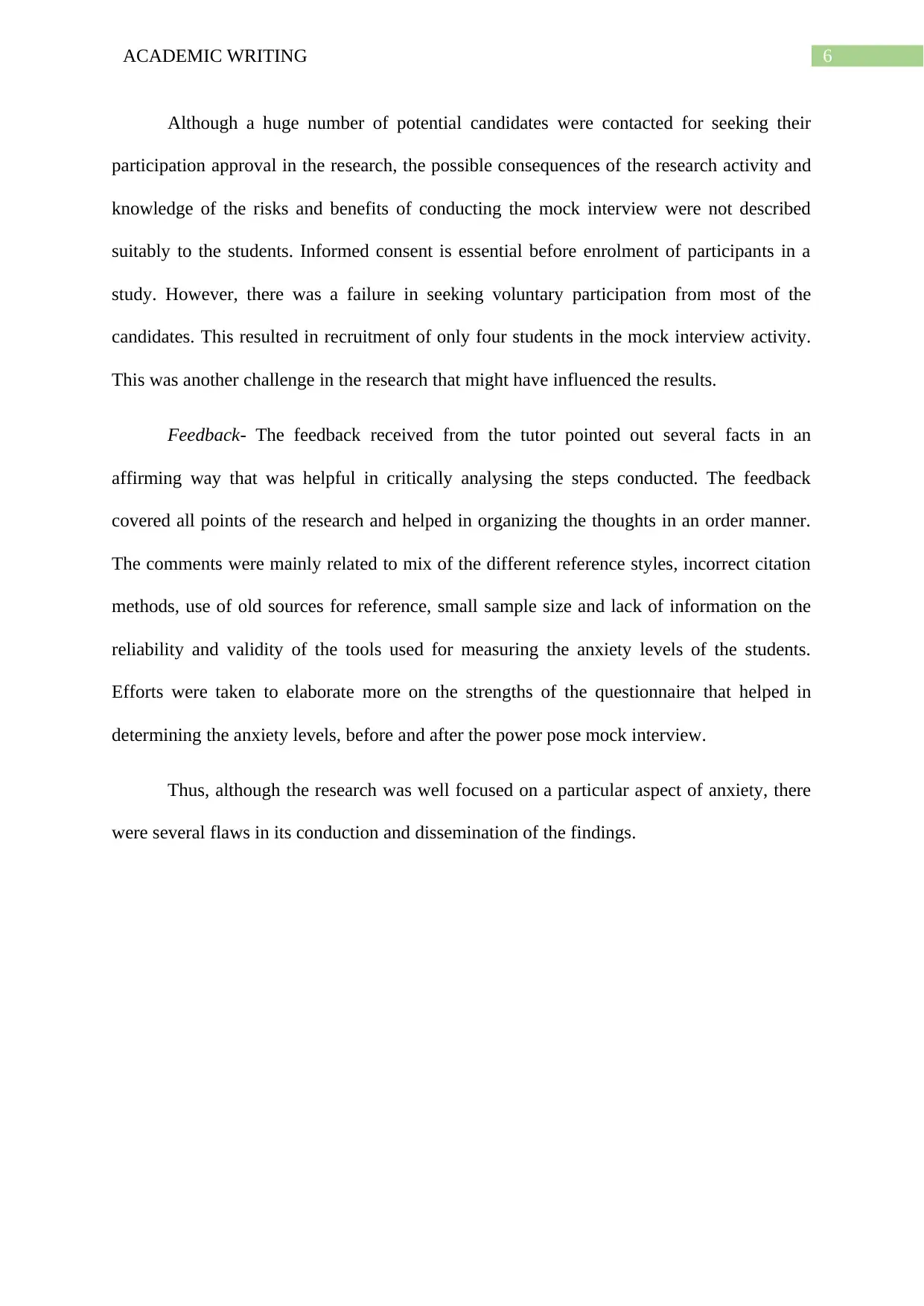
6ACADEMIC WRITING
Although a huge number of potential candidates were contacted for seeking their
participation approval in the research, the possible consequences of the research activity and
knowledge of the risks and benefits of conducting the mock interview were not described
suitably to the students. Informed consent is essential before enrolment of participants in a
study. However, there was a failure in seeking voluntary participation from most of the
candidates. This resulted in recruitment of only four students in the mock interview activity.
This was another challenge in the research that might have influenced the results.
Feedback- The feedback received from the tutor pointed out several facts in an
affirming way that was helpful in critically analysing the steps conducted. The feedback
covered all points of the research and helped in organizing the thoughts in an order manner.
The comments were mainly related to mix of the different reference styles, incorrect citation
methods, use of old sources for reference, small sample size and lack of information on the
reliability and validity of the tools used for measuring the anxiety levels of the students.
Efforts were taken to elaborate more on the strengths of the questionnaire that helped in
determining the anxiety levels, before and after the power pose mock interview.
Thus, although the research was well focused on a particular aspect of anxiety, there
were several flaws in its conduction and dissemination of the findings.
Although a huge number of potential candidates were contacted for seeking their
participation approval in the research, the possible consequences of the research activity and
knowledge of the risks and benefits of conducting the mock interview were not described
suitably to the students. Informed consent is essential before enrolment of participants in a
study. However, there was a failure in seeking voluntary participation from most of the
candidates. This resulted in recruitment of only four students in the mock interview activity.
This was another challenge in the research that might have influenced the results.
Feedback- The feedback received from the tutor pointed out several facts in an
affirming way that was helpful in critically analysing the steps conducted. The feedback
covered all points of the research and helped in organizing the thoughts in an order manner.
The comments were mainly related to mix of the different reference styles, incorrect citation
methods, use of old sources for reference, small sample size and lack of information on the
reliability and validity of the tools used for measuring the anxiety levels of the students.
Efforts were taken to elaborate more on the strengths of the questionnaire that helped in
determining the anxiety levels, before and after the power pose mock interview.
Thus, although the research was well focused on a particular aspect of anxiety, there
were several flaws in its conduction and dissemination of the findings.
Paraphrase This Document
Need a fresh take? Get an instant paraphrase of this document with our AI Paraphraser
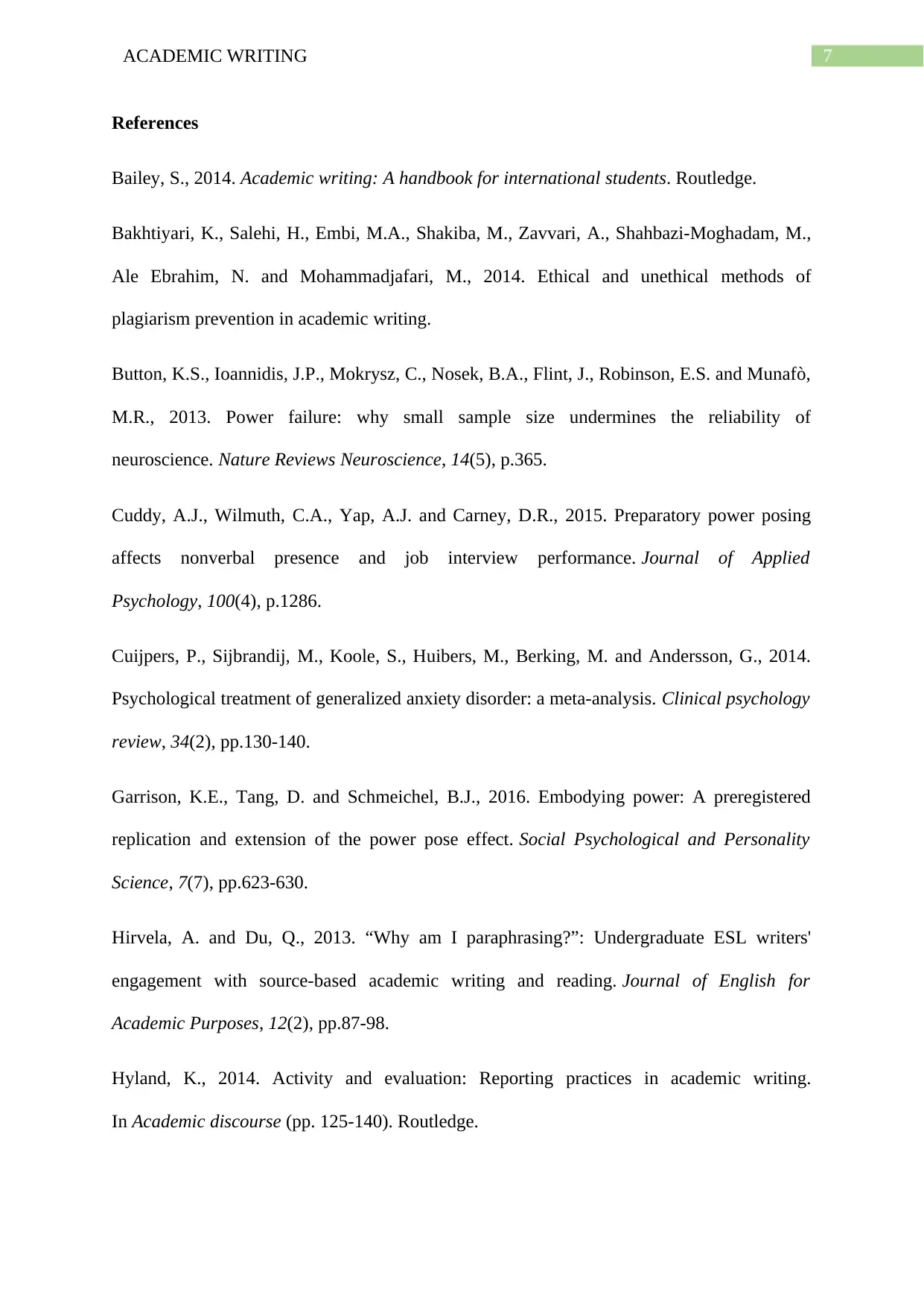
7ACADEMIC WRITING
References
Bailey, S., 2014. Academic writing: A handbook for international students. Routledge.
Bakhtiyari, K., Salehi, H., Embi, M.A., Shakiba, M., Zavvari, A., Shahbazi-Moghadam, M.,
Ale Ebrahim, N. and Mohammadjafari, M., 2014. Ethical and unethical methods of
plagiarism prevention in academic writing.
Button, K.S., Ioannidis, J.P., Mokrysz, C., Nosek, B.A., Flint, J., Robinson, E.S. and Munafò,
M.R., 2013. Power failure: why small sample size undermines the reliability of
neuroscience. Nature Reviews Neuroscience, 14(5), p.365.
Cuddy, A.J., Wilmuth, C.A., Yap, A.J. and Carney, D.R., 2015. Preparatory power posing
affects nonverbal presence and job interview performance. Journal of Applied
Psychology, 100(4), p.1286.
Cuijpers, P., Sijbrandij, M., Koole, S., Huibers, M., Berking, M. and Andersson, G., 2014.
Psychological treatment of generalized anxiety disorder: a meta-analysis. Clinical psychology
review, 34(2), pp.130-140.
Garrison, K.E., Tang, D. and Schmeichel, B.J., 2016. Embodying power: A preregistered
replication and extension of the power pose effect. Social Psychological and Personality
Science, 7(7), pp.623-630.
Hirvela, A. and Du, Q., 2013. “Why am I paraphrasing?”: Undergraduate ESL writers'
engagement with source-based academic writing and reading. Journal of English for
Academic Purposes, 12(2), pp.87-98.
Hyland, K., 2014. Activity and evaluation: Reporting practices in academic writing.
In Academic discourse (pp. 125-140). Routledge.
References
Bailey, S., 2014. Academic writing: A handbook for international students. Routledge.
Bakhtiyari, K., Salehi, H., Embi, M.A., Shakiba, M., Zavvari, A., Shahbazi-Moghadam, M.,
Ale Ebrahim, N. and Mohammadjafari, M., 2014. Ethical and unethical methods of
plagiarism prevention in academic writing.
Button, K.S., Ioannidis, J.P., Mokrysz, C., Nosek, B.A., Flint, J., Robinson, E.S. and Munafò,
M.R., 2013. Power failure: why small sample size undermines the reliability of
neuroscience. Nature Reviews Neuroscience, 14(5), p.365.
Cuddy, A.J., Wilmuth, C.A., Yap, A.J. and Carney, D.R., 2015. Preparatory power posing
affects nonverbal presence and job interview performance. Journal of Applied
Psychology, 100(4), p.1286.
Cuijpers, P., Sijbrandij, M., Koole, S., Huibers, M., Berking, M. and Andersson, G., 2014.
Psychological treatment of generalized anxiety disorder: a meta-analysis. Clinical psychology
review, 34(2), pp.130-140.
Garrison, K.E., Tang, D. and Schmeichel, B.J., 2016. Embodying power: A preregistered
replication and extension of the power pose effect. Social Psychological and Personality
Science, 7(7), pp.623-630.
Hirvela, A. and Du, Q., 2013. “Why am I paraphrasing?”: Undergraduate ESL writers'
engagement with source-based academic writing and reading. Journal of English for
Academic Purposes, 12(2), pp.87-98.
Hyland, K., 2014. Activity and evaluation: Reporting practices in academic writing.
In Academic discourse (pp. 125-140). Routledge.
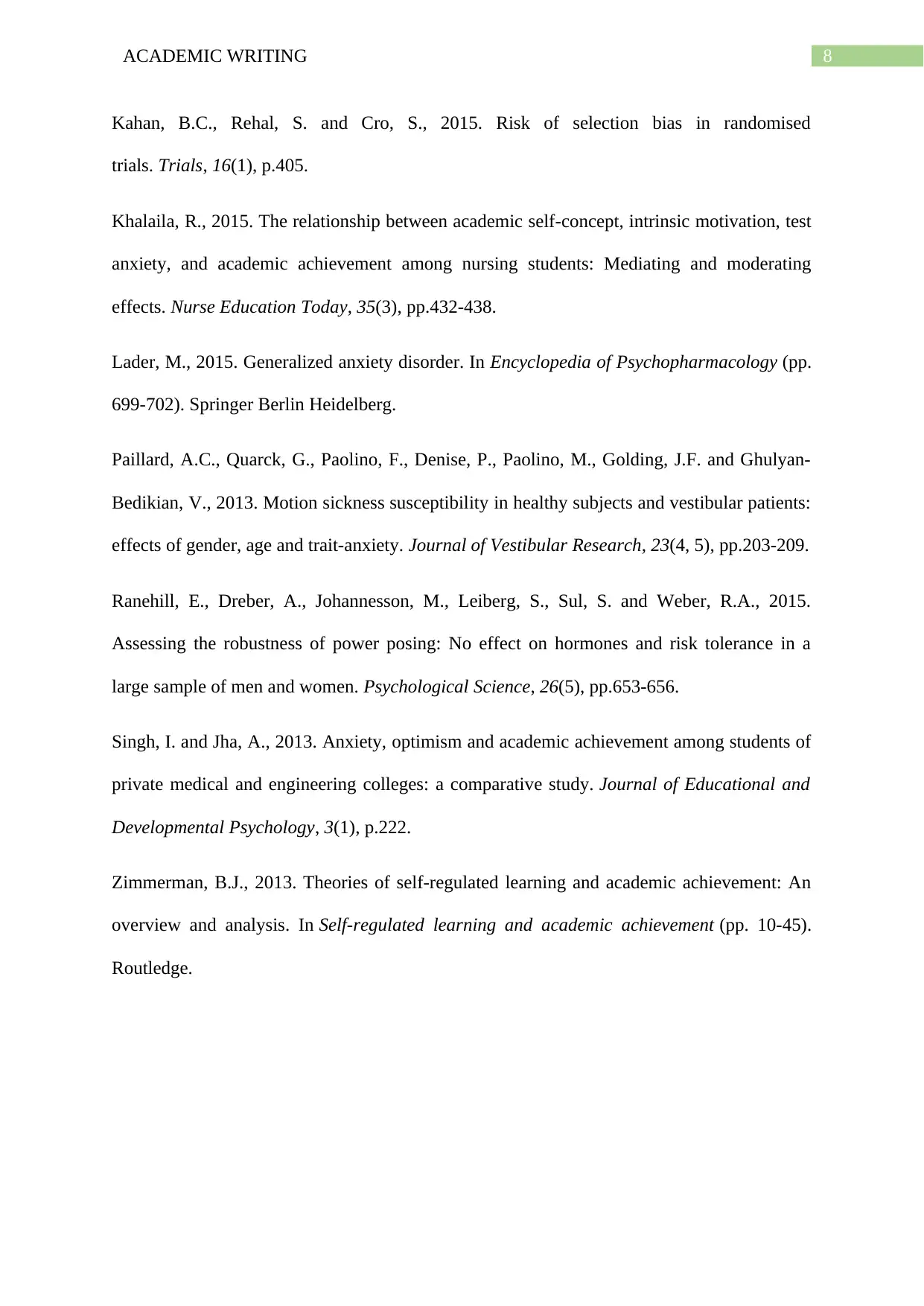
8ACADEMIC WRITING
Kahan, B.C., Rehal, S. and Cro, S., 2015. Risk of selection bias in randomised
trials. Trials, 16(1), p.405.
Khalaila, R., 2015. The relationship between academic self-concept, intrinsic motivation, test
anxiety, and academic achievement among nursing students: Mediating and moderating
effects. Nurse Education Today, 35(3), pp.432-438.
Lader, M., 2015. Generalized anxiety disorder. In Encyclopedia of Psychopharmacology (pp.
699-702). Springer Berlin Heidelberg.
Paillard, A.C., Quarck, G., Paolino, F., Denise, P., Paolino, M., Golding, J.F. and Ghulyan-
Bedikian, V., 2013. Motion sickness susceptibility in healthy subjects and vestibular patients:
effects of gender, age and trait-anxiety. Journal of Vestibular Research, 23(4, 5), pp.203-209.
Ranehill, E., Dreber, A., Johannesson, M., Leiberg, S., Sul, S. and Weber, R.A., 2015.
Assessing the robustness of power posing: No effect on hormones and risk tolerance in a
large sample of men and women. Psychological Science, 26(5), pp.653-656.
Singh, I. and Jha, A., 2013. Anxiety, optimism and academic achievement among students of
private medical and engineering colleges: a comparative study. Journal of Educational and
Developmental Psychology, 3(1), p.222.
Zimmerman, B.J., 2013. Theories of self-regulated learning and academic achievement: An
overview and analysis. In Self-regulated learning and academic achievement (pp. 10-45).
Routledge.
Kahan, B.C., Rehal, S. and Cro, S., 2015. Risk of selection bias in randomised
trials. Trials, 16(1), p.405.
Khalaila, R., 2015. The relationship between academic self-concept, intrinsic motivation, test
anxiety, and academic achievement among nursing students: Mediating and moderating
effects. Nurse Education Today, 35(3), pp.432-438.
Lader, M., 2015. Generalized anxiety disorder. In Encyclopedia of Psychopharmacology (pp.
699-702). Springer Berlin Heidelberg.
Paillard, A.C., Quarck, G., Paolino, F., Denise, P., Paolino, M., Golding, J.F. and Ghulyan-
Bedikian, V., 2013. Motion sickness susceptibility in healthy subjects and vestibular patients:
effects of gender, age and trait-anxiety. Journal of Vestibular Research, 23(4, 5), pp.203-209.
Ranehill, E., Dreber, A., Johannesson, M., Leiberg, S., Sul, S. and Weber, R.A., 2015.
Assessing the robustness of power posing: No effect on hormones and risk tolerance in a
large sample of men and women. Psychological Science, 26(5), pp.653-656.
Singh, I. and Jha, A., 2013. Anxiety, optimism and academic achievement among students of
private medical and engineering colleges: a comparative study. Journal of Educational and
Developmental Psychology, 3(1), p.222.
Zimmerman, B.J., 2013. Theories of self-regulated learning and academic achievement: An
overview and analysis. In Self-regulated learning and academic achievement (pp. 10-45).
Routledge.
⊘ This is a preview!⊘
Do you want full access?
Subscribe today to unlock all pages.

Trusted by 1+ million students worldwide
1 out of 9
Related Documents
Your All-in-One AI-Powered Toolkit for Academic Success.
+13062052269
info@desklib.com
Available 24*7 on WhatsApp / Email
![[object Object]](/_next/static/media/star-bottom.7253800d.svg)
Unlock your academic potential
Copyright © 2020–2025 A2Z Services. All Rights Reserved. Developed and managed by ZUCOL.





